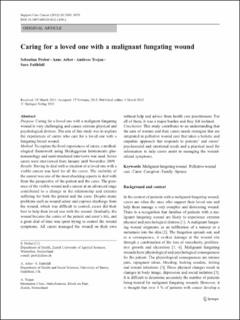Please use this identifier to cite or link to this item:
https://doi.org/10.21256/zhaw-2742| Publication type: | Article in scientific journal |
| Type of review: | Peer review (publication) |
| Title: | Caring for a loved one with a malignant fungating wound |
| Authors: | Probst, Sebastian Arber, A. Faithfull, S. |
| DOI: | 10.21256/zhaw-2742 10.1007/s00520-012-1430-y |
| Published in: | Supportive Care in Cancer |
| Volume(Issue): | 12 |
| Issue: | 20 |
| Page(s): | 3065 |
| Pages to: | 3070 |
| Issue Date: | 2012 |
| Publisher / Ed. Institution: | Springer |
| ISSN: | 0941-4355 1433-7339 |
| Language: | English |
| Subjects: | Palliative wound care; Carer; Spouse; Malignant fungating wound |
| Subject (DDC): | 610.73: Nursing 616: Internal medicine and diseases |
| Abstract: | Purpose: Caring for a loved one with a malignant fungating wound is very challenging and causes extreme physical and psychological distress. The aim of this study was to explore the experiences of carers who care for a loved one with a fungating breast wound. Method: To explore the lived experiences of carers, a methodological framework using Heideggerian hermeneutic phenomenology and semi-structured interviews was used. Seven carers were interviewed from January until November 2009. Results: Having to deal with a situation of a loved one with a visible cancer was hard for all the carers. The visibility of the cancer was one of the most shocking aspects to deal with from the perspective of the patient and the carer. The presence of the visible wound and a cancer at an advanced stage contributed to a change in the relationship and extreme suffering for both the patient and the carer. Despite many problems such as wound odour and copious discharge from the wound, which was difficult to control, carers did their best to help their loved one with the wound. Gradually, the wound became the centre of the patient and carer’s life, and a great deal of time was spent trying to control the wound symptoms. All carers managed the wound on their own without help and advice from health care practitioners. For all of them, it was a major burden and they felt isolated. Conclusion: This study contributes to an understanding that the care of women and their carers needs strategies that are integrated in palliative wound care that takes a holistic and empathic approach that responds to patients’ and carers’ psychosocial and emotional needs and a practical need for information to help carers assist in managing the wound-related symptoms. |
| Further description: | Erworben im Rahmen der Schweizer Nationallizenzen (http://www.nationallizenzen.ch) |
| URI: | https://digitalcollection.zhaw.ch/handle/11475/12464 |
| Fulltext version: | Published version |
| License (according to publishing contract): | Licence according to publishing contract |
| Departement: | School of Health Sciences |
| Organisational Unit: | Institute of Nursing (IPF) |
| Appears in collections: | Publikationen Gesundheit |
Files in This Item:
| File | Description | Size | Format | |
|---|---|---|---|---|
| 2012_Probst_Caring for a loved one_SupportCareCancer.pdf | 128.29 kB | Adobe PDF |  View/Open |
Show full item record
Probst, S., Arber, A., & Faithfull, S. (2012). Caring for a loved one with a malignant fungating wound. Supportive Care in Cancer, 12(20), 3065–3070. https://doi.org/10.21256/zhaw-2742
Probst, S., Arber, A. and Faithfull, S. (2012) ‘Caring for a loved one with a malignant fungating wound’, Supportive Care in Cancer, 12(20), pp. 3065–3070. Available at: https://doi.org/10.21256/zhaw-2742.
S. Probst, A. Arber, and S. Faithfull, “Caring for a loved one with a malignant fungating wound,” Supportive Care in Cancer, vol. 12, no. 20, pp. 3065–3070, 2012, doi: 10.21256/zhaw-2742.
PROBST, Sebastian, A. ARBER und S. FAITHFULL, 2012. Caring for a loved one with a malignant fungating wound. Supportive Care in Cancer. 2012. Bd. 12, Nr. 20, S. 3065–3070. DOI 10.21256/zhaw-2742
Probst, Sebastian, A. Arber, and S. Faithfull. 2012. “Caring for a Loved One with a Malignant Fungating Wound.” Supportive Care in Cancer 12 (20): 3065–70. https://doi.org/10.21256/zhaw-2742.
Probst, Sebastian, et al. “Caring for a Loved One with a Malignant Fungating Wound.” Supportive Care in Cancer, vol. 12, no. 20, 2012, pp. 3065–70, https://doi.org/10.21256/zhaw-2742.
Items in DSpace are protected by copyright, with all rights reserved, unless otherwise indicated.